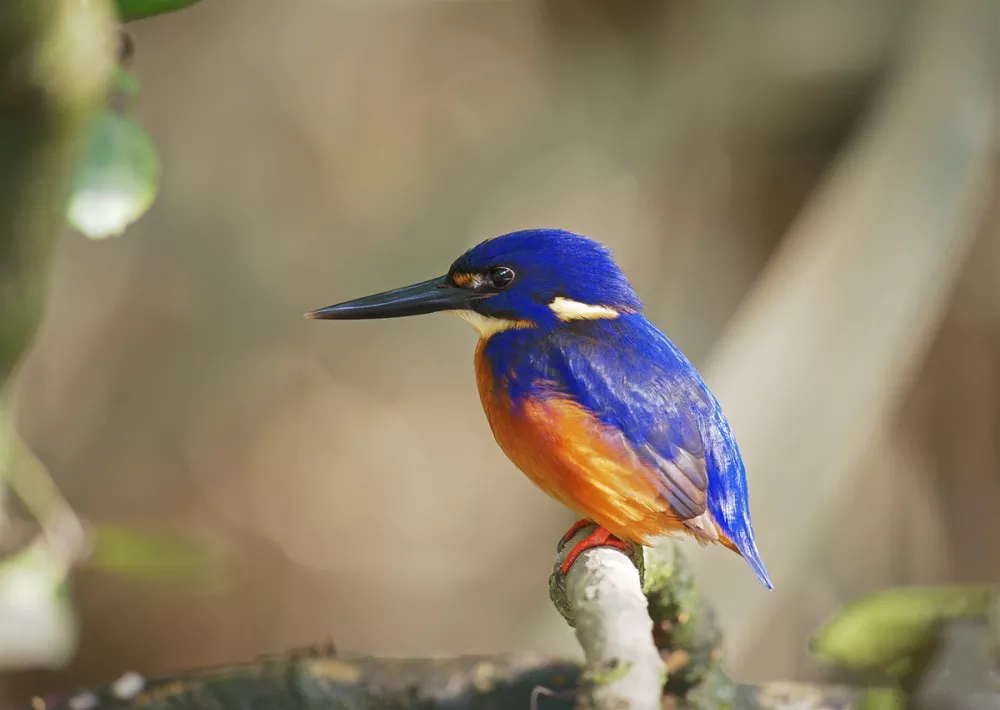The azure kingfisher (Ceyx azureus) is a small kingfisher in the river kingfisher subfamily, Alcedininae.
The azure kingfisher has a thick and straight mouth, long and pointed. The food is mainly small fish, and also eats crustaceans, various aquatic insects and their larvae, as well as small frogs and a small amount of aquatic plants.
What does Azure kingfisher look like
Azure kingfisher is a small bird mainly composed of bright blue and orange feathers, with a body length of 17-19 cm, a wingspan of 25-29 cm, and a weight of 40 grams. The body feathers are gorgeous and brilliant, the head and back feathers are blue and shiny, the chest and abdomen are beautiful and bright orange red or reddish brown, there are some black spots on the wings, white spots on the back neck and throat, and mottled tail tip Gray black with bright red legs and feet.
The mouth is thick and straight, long and pointed, and the ridge of the mouth is round; the nasal groove is not obvious; the wing tip is long, the first primary flight feather is slightly shorter, and the third and fourth are the longest; the tail is short and round; the head is large, the neck is short, and the wings are short Round, mostly short tails; long and pointed mouth, blunt mouth peak, very short feet, thin and thin toes, the 4th toe is mostly connected with the 3rd toe, and only the base of the 2nd toe is connected. Tail glands (Ran Yu). There are black coracoids on both sides, 4 notches on the posterior edge of the sternum, and the manubrium is simply formed by external spines.
Azure kingfisher habitat
Habitat in shrubs or sparse forests, clear and slow-flowing creeks, streams, lakes, brooks, bays, mangroves, and even those reservoirs near urban areas.
Azure kingfisher living habit
It often moves alone, and usually lives alone on branches or rocks near the water, and sometimes rests on the low branches of small trees near the river. They often stare at the water surface motionlessly for a long time, and when they see fish and shrimp in the water, they immediately plunge into the water with a very fast and fierce posture to catch them with their mouths. Sometimes it also flaps its wings to suspend in the air, and looks down at the water surface. When it sees food, it immediately plunges into the water and catches it quickly. Usually the prey is brought back to its habitat, beaten on a branch or stone, and swallowed whole after the fish dies. Sometimes it also flies along the water surface in a low-altitude straight line, the flying speed is very fast, and it often calls while flying.
What do Azure kingfishers eat
The food is mainly small fish, and also eats crustaceans, various aquatic insects and their larvae, as well as small frogs and a small amount of aquatic plants. After the kingfisher plunges into the water, it can still maintain excellent eyesight, because its eyes can quickly adjust the contrast of the angle of view caused by the light in the water after entering the water. So the fishing skills are very strong.
Distribution range of Azure kingfisher
Distributed in Australia, Indonesia and Papua New Guinea.
Mode of reproduction
The breeding season is between October and December, but generally lasts until January of the following year. There is a courtship flight before the nesting, and the two sides continue to chase and dance along the winding streams and rivers. Azure kingfisher is monogamous. Nest on the dams of rivers or streams, dig tunnel-like caves with their mouths, the caves are 80 cm to 1.30 meters deep, these caves generally do not add grass leaves and feathers as bedding, but put some small cartilage and shell fragments For decoration, the eggs are laid directly on the nest floor. Each clutch lays 4-7 eggs. Egg color is bluish white, shiny, slightly speckled, about 28 mm x 18 mm in size, 1-2 broods per year; incubation period is about 21 days, both sexes incubate eggs, but only the female feeds the chicks, and the young birds nurse for 3-4 weeks After that, they can live independently.


 Facebook
Facebook  Instagram
Instagram  Youtube
Youtube 